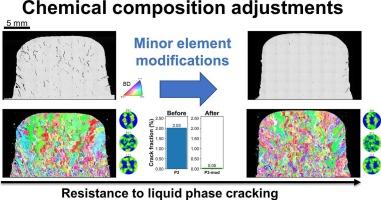Improving crack reduction by tailoring minor element content in γ/γ′ cobalt-based superalloys processed by directed energy deposition
IF 7.9
2区 材料科学
Q1 MATERIALS SCIENCE, MULTIDISCIPLINARY
引用次数: 0
Abstract
This study investigates the possibility of manufacturing γ/γ′ cobalt-based superalloys by Directed Energy Deposition (DED). Due to their complex chemical composition, these alloys are highly sensitive to liquid phase cracking mechanisms, particularly at high-angle grain boundaries. The cracking sensitivity of two alloys is investigated in relation to chemical modifications of minor elements and changes in process parameters. Four different parameter sets are employed, resulting in four distinct microstructures. Regardless of the process parameters, changes in minor elements such as boron, zirconium, and silicon significantly influence the cracking sensitivity of the alloys. Reducing their content leads directly to an improvement in the as-built material’s health due to an increase in the solidification temperature of the final liquid pocket. The role of grain boundary density and length is also emphasized in regard to the cracking response of the samples. Increasing the density of high-angle grain boundaries allows for a better distribution of solutes and stresses across multiple interfaces. However, the reduction in cracking is less pronounced with changes in process parameters than with reductions in minor element content. This work highlights the importance of tailoring minor element content for additive manufacturing and provides guidance for the design of new alloys.

定向能沉积γ/γ′钴基高温合金中微量元素含量的调整提高了裂纹的止裂性
本研究探讨了定向能沉积(DED)制备γ/γ′钴基高温合金的可能性。由于其复杂的化学成分,这些合金对液相开裂机制非常敏感,特别是在高角度晶界处。研究了两种合金的开裂敏感性与微量元素化学改性和工艺参数变化的关系。采用了四种不同的参数集,得到了四种不同的微观结构。无论工艺参数如何,硼、锆和硅等微量元素的变化都会显著影响合金的开裂敏感性。由于提高了最终液袋的凝固温度,减少它们的含量直接改善了成品材料的健康状况。晶界密度和晶界长度对试样的开裂响应也有重要影响。增加高角度晶界的密度可以使溶质和应力在多个界面上更好地分布。然而,开裂的减少与工艺参数的变化相比,与微量元素含量的减少相比不那么明显。这项工作强调了在增材制造中定制微量元素含量的重要性,并为新合金的设计提供了指导。
本文章由计算机程序翻译,如有差异,请以英文原文为准。
求助全文
约1分钟内获得全文
求助全文
来源期刊

Materials & Design
Engineering-Mechanical Engineering
CiteScore
14.30
自引率
7.10%
发文量
1028
审稿时长
85 days
期刊介绍:
Materials and Design is a multi-disciplinary journal that publishes original research reports, review articles, and express communications. The journal focuses on studying the structure and properties of inorganic and organic materials, advancements in synthesis, processing, characterization, and testing, the design of materials and engineering systems, and their applications in technology. It aims to bring together various aspects of materials science, engineering, physics, and chemistry.
The journal explores themes ranging from materials to design and aims to reveal the connections between natural and artificial materials, as well as experiment and modeling. Manuscripts submitted to Materials and Design should contain elements of discovery and surprise, as they often contribute new insights into the architecture and function of matter.
 求助内容:
求助内容: 应助结果提醒方式:
应助结果提醒方式:


